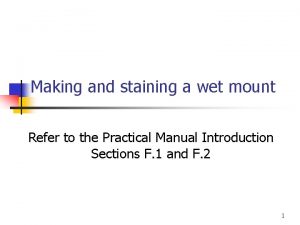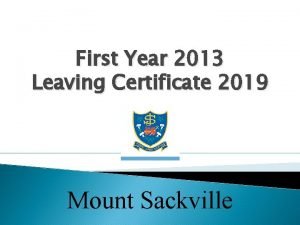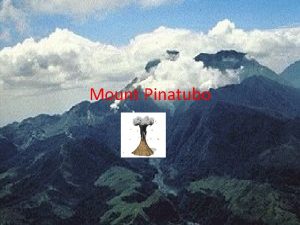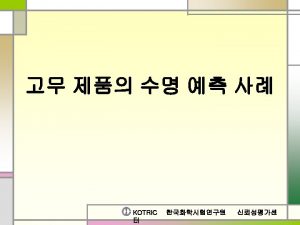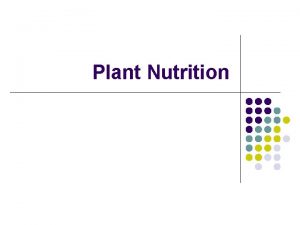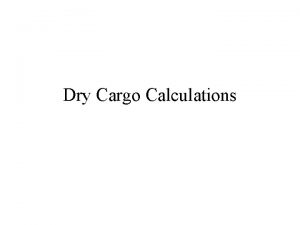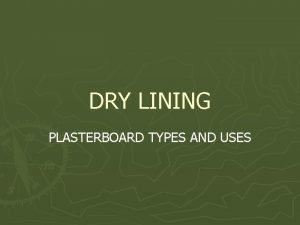Dry mount of plant Dry mount of plant

















- Slides: 17

Dry mount of plant

Dry mount of plant Preserved plants specimens provide us with important information about plant diversity and distribution

The steps of plant preserving: A. Allow and support accurate identification of plants, algae, lichens and fungi. B. Provide a permanent record for a species occurring at a particular time and place. C. Form the basis of reliable distribution, habit and habitat information. D. Provide basic biological material for taxonomists, ecologists and other researchers. E. Serve as vouchers for seed collections, toxicological cases, biochemical analyses and biodiscovery.

The main equipment for plant collection are: 1 -A field press with newspapers for plant pressing

2 - Secateurs to cut and trim specimens

3 - GPS for recording an accurate latitude and longitude. Alternatively, mark the position on a topographic map.

4 - Small brown paper bags for collecting fruits, seeds, bryophytes and lichens. 5 - Hand lens. 6 - Gloves, for handling prickly plant material or plants with corrosive sap.

2 - Pressing and Drying plant specimens *Specimens are pressed in a plant field press, which consists of a wooden frame (for rigidity) *corrugated cardboard ventilators (to allow air to flow through the press) *blotter paper (to absorb moisture), folded paper, typically a newspaper (to contain the plant material).

This process is essential to dry the specimens fairly quickly, to prevent the onset of fungal attack. Fungus affected specimens are of limited value to a Herbarium. The drying of plant specimens have been usually done in field by placing the presses top most in the sun during the day appears to have little drying effect except for the bottommost specimens. However, the sun is invaluable for drying the damp papers and corrugates once they have been removed from the press.

3 - Writing label (Voucher specimen) The data that accompanies a herbarium specimen is just as important as the specimen itself. Even a very good quality specimen is of no use to a Herbarium unless it has a written label with the information detailed below. Collector’s name: the name (s) of the person/people who collected the specimen preferably no more than 2 people (Don't include everyone who was on the Trip). Collector's number: A unique number, usually sequential, given by the collector as a private record. Date of collection: in form of day/ month/ year Botanical name: If you are unsure of the identity it is still helpful to suggest a name, or at least a genus. Locality: A written description of the precise collection locality is necessary as well as a latitude and longitude reading. Habitat: This information is copied from the field note book, for example “spreading shrub to 2 m “. Abundance: A comment on the frequency (number of individuals) of the plant at the site where you collected. See the example in the next two slides below


Sample for Voucher specimen

Step-by-step procedure for plant collecting and pressing 1. Find a specimen that is representative of the existing population. Collect both flowers and fruit if available. 2. Use secateurs for a clean cut of the stem. Collect two specimens if you wish to retain one sample for yourself.

3. Every specimen and its duplicates should be tagged. Jeweller's tags are used by most botanists. Write your name or initials and a unique collection number on one side, and the date and site number on the other side. Use a pencil or waterproof pen. 4. Attach tags securely to each specimen.

5. Consider how the pressed specimen will appear. Its form at this time largely determines its ultimate appearance. Unnecessary twiggy shoots and excess material may be cut away. 6. Flatten out the specimen by closing the day-press and securely attaching the straps (in this case, Velcro straps).

7. Record the latitude and longitude of the site using a GPS unit. Alternatively, mark your position on a map, and record the grid reference. 8. Record site/habitat data (locality, soil/geology, vegetation type, associated species) and individual specimen data (habit, flower colour, abundance) in a notebook. All notes should be recorded at the collecting site and not at a later time.

9. Example of a mounted and labelled herbarium specimen. (Hymenachne amplexicaulis).
 Dry steam geothermal power plant
Dry steam geothermal power plant Plant introduction in plant breeding
Plant introduction in plant breeding Tronsmo plant pathology and plant diseases download
Tronsmo plant pathology and plant diseases download Introduction in plant breeding
Introduction in plant breeding Tronsmo plant pathology and plant diseases download
Tronsmo plant pathology and plant diseases download Plant introduction in plant breeding
Plant introduction in plant breeding Tronsmo plant pathology and plant diseases download
Tronsmo plant pathology and plant diseases download Mount litera zee school chandrapur
Mount litera zee school chandrapur Mount merapi facts
Mount merapi facts Mount everest
Mount everest Gj mount classification of caries
Gj mount classification of caries What's it called
What's it called Trans umbrella
Trans umbrella Mount rainier eruption simulation
Mount rainier eruption simulation Sir edmund hillary
Sir edmund hillary Cover slips drawing
Cover slips drawing Mount sackville
Mount sackville Pulse site
Pulse site















